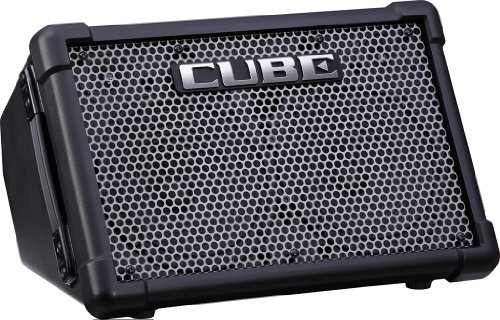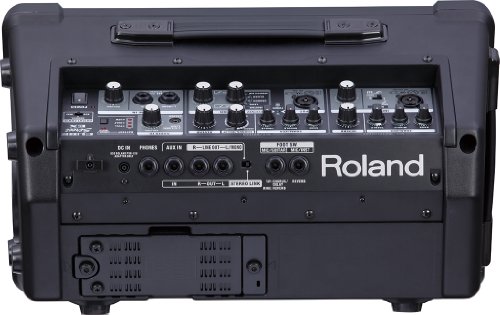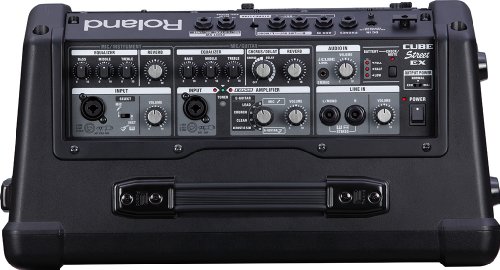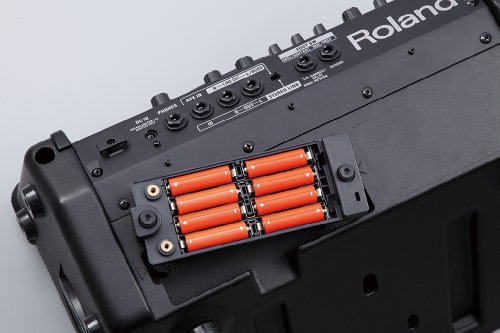- Angled back for use as a stage monitor; mounting hole for use with optional ST-A95 . (Best with Polaroid AA Batteries)
- Power: 50W (25W & 25W stereo)AC or battery-powered (5 hours at 50W; 10 hours at 25W; 20 hours at 10W)Speakers: 2x8" woofers; 2x2" tweeters
- Four independent channels for connecting a variety of mics, instruments, and audio devices
- Two XLR mic inputs allow two vocalists to perform at once
- COSM tones for electric guitar, including Clean, Crunch, and Lead; preamp for acoustic guitar provides clean, natural sound
-
Information
-
Twitter
-
Pinterest
-
Youtube
-
Facebook





Shelly Mae
Amazing Tone & Portability
This amp is incredible. Do not let its size fool you. The tone, accuracy of reproducing what is plugged into it is amazing! Its light weight makes it perfect for small and probably some medium venue gigs. The clean, lead and crunch effects, are a ton of fun. I was especially pleased that the amp reproduces my acoustic guitar tones every bit as wonderfully as the electric guitar. The only thing I'm disappointed in is that the amp does not have built-in Phantom Power for my condenser mics. This means I have to use an additional device - not a huge deal but nevertheless...... All in all, this a no-brainer purchase. If you are looking for portability (no electric cord needed!!!!) in a small amp/PA system, then look no further!!!!
Oulyme Odiug
Great little PA
I play in an acoustic trio and we often need a little volume boost, but hauling around a PA and setting it up is a hassle and there usually isn't a lot of room for that at the gigs we play. The bass player uses a battery powered Roland Cube Bass amp, so I figured I'd try out the street cubes for our vocals and instruments. They arrived in perfect condition and were surprisingly light weight. I hooked one up to a mic and guitar and they sounded clean and clear, the effects were very adequate. We used them a few days later at an outdoor wedding and they were perfect! Everyone could hear us and they said it sounded really nice. While we we're sound checking on a few songs, the DJ they hired for the wedding told my wife, who was listening for us, that we sounded great and asked where we were plugged in. He was shocked to hear we were playing through little battery powered wedge speakers! I really like these and will use them for extra sound when needed, or as monitors to a full PA for larger gigs. I can also use them as a solo performer. The power settings are great for more volume or less battery consumption, and being able to connect multiple units and mix it all together is really efficient and adds to the overall sound.
Claudia Kaya Leal
Very impressed
Purchased this item for outdoor use and it works fantastic. Plenty loud. I wish carry bag was a little less expensive.
Joel Olry
Mighty mite!
This thing blows me away in theory and performance. I never in my life thought I could get SO MUCH sound out of just a few AA batteries for as long as I do, good rechargeable batteries used. Add to that it's versatility and load of functions and for the solo artist, it's a phenomenally light and powerful little amp. I also bought the over priced yet perfectly fitting cover for it from Roland as well.
Felipe Aya Sanchez
Five Stars
Excellent vocal / guitar amp! Worth the money!
Katie Elizabeth
Roland Cube street ex is a magical amp
Great amp can play my clasical guitar,keyboards and mike plus my rythym machine all at the same time, 50 watts is powerful and can be used in most playing situations. The sound is good. Thru the accoustic setting my classical electric taylor sounds hours of battery time when you have the 50 watt power on. You can also use a different watts and you can add at least 4 more hours. For most playing situations this amp will do the job .
Sharon Tribe
flexible and portable but has its shortcomings
I bought this for a guitar amp and vocal PA because the battery operation gives me the freedom to go out without lugging a generator, or a battery and inverter. Still, to be a success, it will have to be good enough that I won't regret not bringing a better PA. My immediate need is for an amp for two electric guitars, and at least one vocal mic. I considered the battery-powered options, building my own PA with a mixer, a 12V car audio amp, speakers and an AGM power-sports battery, and using a car battery, inverter, and a 120V portable PA. The CUBE Street EX obviously wins for simplicity, but I questioned whether it would do everything I need. For a solo singer/player, this amp has plenty of inputs. There's two mic level pre-amps available, and two stereo inputs for a total of six channels (eight if you count aux in that does not have gain/volume). I'll start with the dedicated mic channel. It can be switched to "inst." The specs say this is -10dBu (same as line level). There's no gain adjustment, only a volume knob which seems more like a post amp fader. There's also a three band equalizer with fixed mid, and a reverb knob. I like to have more power to tweak vocals, so I'm using a Helicon pedal that has its own adjustable gain pre-amp, phantom power, as well as pre-set compressor, de-esser, and EQ. It also provides a handful of reverb styles and modest pitch correction. There's no way I'm going portable with the rack of equipment to do all that traditionally, but the practical alternative here would be a compact mixer with adjustable gain, and a built-in compressor, and 3 band EQ with sweepable mid. The pedal offers a lot for its size. The mixer is primarily worth considering if more channels or preamps are needed. Because of the outboard options, I really don't need more from the Street EX than a clean mic channel and good reproduction in the vocal ranges. It seems to offer all that. The guitar channel can be used as another mic channel, but it also has built-in guitar effects. The effects are limited, but totally simple. That simplicity is better for me than the great deal more options a guitarist would get from a pedal board or a multi-effect pedal. I also considered the Vox Stomplab as a super simple-to-use multi-effect pedal, and the Helicon Play Electric which combines the vocal effects with guitar effects in one pedal. The Stomplab could be a good choice for easy to select presets when the PA doesn't have anything, but nothing could be simpler than this Cube Street EX. The Play Electric offers myriad effects and combines vocals for harmony, and fewer boxes overall, but based on my reading the manual, its features are matched by complexity. My guitarists are kids, and I'd rather spend time playing than explaining multi-layered menu options. The variety and quality of the guitar effects are great. Really, I would be satisfied with an acoustic sound, a clean electric, and distorted, but the Street EX offers a few more choices, plus reverb, chorus, delay, and EQ. Again, my needs are for simplicity while still allowing flexibility. I've read the opinions of more experience guitarists and there seems to be some consensus that the Street EX is fantastic for acoustic guitars, but probably doesn't offer everything the electric guitarist would want. Outboard effects could address some of that, but obviously this is never going to sound like a full Marshall stack. So how does it sound with the guitar? I compared it carefully to my Fender Mustang 1 V2 with both amps on the clean channel. The Mustang 1 is a 30W, 1x8" solid state modeling amp. The biggest difference is probably that the Street EX has 2x2" tweeters. The electric guitar channels obviously have some kind of crossover or a low-pass filter. It still seems like more treble comes through than what the Mustang has, but if I switch the channel to microphone mode, all the harsh treble comes through the tweeters. Back in clean mode, I fiddled with the EQ and found I could come close to matching the Fender's 1x8" cabinet if I turned the high down and the bass up a bit. Compared to the 30W Fender, the Street EX was quite a bit louder. With the Fender cranked all the way up to the point it was overdriving, I could get a maybe 105 dBA at 1M strumming the guitar, playing an open E string, and so on. I could match that on the Street EX with the volume turned less than half-way up. But cranking the Street EX didn't just continue to increase SPL. I could get it over 110dBA at 1M, but the last quarter-turn just overdrove it an made it more distorted without getting any louder. The Street EX is amazingly loud for an amp powered by eight AA batteries. I'm sure this is due to a very efficient class-D amplifier, and some efficient drivers. That combination has some shortcomings though. While Roland rates the output of this amp as 2 x 25W (50W), I'm pretty sure they're doing some tricks to get that output figure, and it's certainly a peak figure rather than RMS. The specs indicate it draws 730 milliamps, and at 12V, that's only 8W in. Fender rates the Mustang 1 at 70W input. Neither of these amps are going to blow Marty McFly off the stage, but they have comparable size and power rating claims (at least on the output). Given that the Fender is apparently consuming far more power, but the Roland is putting out a SPL that leaves no question that it's louder, my conclusion is that Roland chose to claim "50W" because it's louder than a "30W" amp. Moving on to the stereo line inputs, I connected a music player and compared it to my 2.1 PC speaker system. This is where the shortcoming of the battery-powered amp and efficient drivers came to light. The 5" subwoofer on my PC has far better bass reproduction than the Street EX. I put the music player on the Fender amp and it too couldn't touch the bass of the little subwoofer. One wouldn't expect to find subwoofer frequency response on a dedicated guitar amp, but the Street EX is more than a guitar amp, it's also a PA. The obvious factor here is the 300W going into the amplifier for the 5" sub. High-powered amps are going to be able to drive long-excursion woofers and inefficient drivers to reproduce transients better than any low-powered system. The bottom line is if a subwoofer will significantly enhance the program material on the PA, a high-powered system is going to be worthwhile. For portable operation that means a generator or a battery ad inverter or automotive system. For the music player, a blue-tooth receiver would make this Street EX better, but I didn't buy it to play recorded music. There are some other portable PA's with that feature built-in like the Mackie Freeplay and Reach. There's also some compact mixers that will pair a bluetooth player, and there are plug-in bluetooth receivers like the Blackstar Tone:Link. Besides the 3.5mm stereo TRS music player jack, which can be used as a stereo line-in, there's a L/R 1/4 TS input pair suitable for a keyboard for example, and there is the AUX in, which can be used as another stereo input, although it does not have a volume knob. I tried it with a music player and it receives a stereo signal and sends it to the amp at full gain. The volume can be lowered externally on the instrument or player. The Aux in jack doubles as the stereo link for a second Street EX. If a musician or band on-the-go wanted a simple portable system but with more inputs than one Street EX offers, a second Street EX might make more sense than a mixer. The second unit isn't that much more weight and bulk than a compact mixer, the cable bundle, and power supply, yet it basically doubles the inputs available to 12 channels (or 16 if you don't link them), and it also doubles the amplifier power, the number of drivers, and offers wider coverage and better stereo separation. At the moment I have two guitarists, and vocals. We also have a horn, but it doesn't use a channel. I considered a mixer or a second Street EX to get two guitar channels because even though I could put the second guitar in the mic channel, I wanted a mic for vocals too. I also wanted to keep the whole system easy to carry. I want three people to be able to carry it and all the instruments, mic, stands, plus personal items (water, jacket, etc) without a car, and without making multiple trips. For the time being I settled on combining the guitar cables using resistors on the rings. It is just like a Y-cable, but with those resistors for the sake of impedance. The result is like a tiny, two-channel, passive mixer. It works fine. I haven't tried combining two mics into one preamp yet, but don't think I'll have to. Because I like the Helicon vocal pedal that has its own preamp (also check out their Perform V), I can put a mic into the L Line-In (which pans a mono signal to both sides). If I ever need that for the keyboard (many of which have stereo samples and effects), I could probably adapt the mic (or the keyboard) to the 3.5mm audio player input. Like the horn, a drummer wouldn't need to be mic'd to accompany guitarists and a keyboard on a PA like this. So this system could easily work for a quartet or better depending on the instruments. It probably wouldn't work the best for a bass or a drum machine (or any electronic music that would benefit from a subwoofer). If you're going to haul a van full of gear, this system doesn't really fit in. You're better off with high-power, better bass, more SPL, and more accuracy on the transients and so forth. A mixer with at least 10 channels and 4 preamps will start to offer more flexibility than this PA by itself, but you'd almost need a 16 channel mixer to do more than two of these Street EX. I wanted to explore the frequency response on this amplifier and speakers a little more, so I used my computer as a source and did some oscillator sweeps with a sine wave generator, and put an SPL meter in front of the speakers. My SPL meter is a calibrated instrument and it can function in dBC mode which gives a flat weighting (dBA is a more common way to average SPL across frequencies, but for the frequency response I want an evenly weighted measurement of one frequency at a time). The Street EX doesn't produce much down in the sub bass frequencies around 30Hz. It's pretty audible at 40Hz, but there is still more than +20dB SPL by the time it gets to 150-200Hz. I measured the -10dB frequency response range for the Street EX (which Roland does not appear to publish) to be 400 - 12kHz. The response curve is definitely not flat. Besides being very quiet under 200Hz, the Street EX gets pretty loud around 400Hz and then has big holes around 2250Hz and 7000Hz. I found if I cranked the bass EQ all the way up, it flattened the response from 60Hz up to 400Hz, but it's so distorted it's unusable. The tweeters are connected in series after the woofers. For a crossover, there is simply a 3.3uF capacitor on each tweeter. According to some charts, that results in a 6dB/octave roll-off below 12KHz. This means that the tweeters are cut by 6dB at 6000Hz, and by 12dB at 3000Hz. That's just the effect of the crossover. Their frequency response will also likely cut them down to nothing significant below a few KHz. If I go portable and get the use out of the freedom the batteries offer, this might be a good guitar amp, but it's lacking as a PA for vocals. The fact that it's frequency response is lacking in the range of vocal fundamentals is a serious issue. For a guitar, it just gives the instrument a certain musical color that might be tolerable if you're not particular about the tone under the circumstances. For the guitar, if I stick around 120VAC, then I might do better with something that's specially tailored for what I'm doing. Maybe a Fishman amp for acoustics, or a Fender, Marshall, or Vox for electric.
Vincent Neron
Have fun anyplace.
This amp is great. We've had a blast with it. I keep it on a speaker tripod stand at home. We are each using guitars and wireless mics. I have gone wireless on my guitar also. Sound is good for the two 8" speakers and tweeters. Can take it anywhere. A bit expensive but I feel I got a good and fun amp. Also sounds very good on acoustic/ecectric guitar
Juanita Walton-Spears
Awesome Amp.
I love this amp, it’s lightweight, loud, and the sound it’s just what I need and more, uses on electric guitar, acoustic, keyboards, audio, mic. If you are looking for a good amp. Get this one you will love it, by the way it’s a battery powered amp. That long last.
Sara Mae Towle
Five Stars
Love this thing for small indoor venues